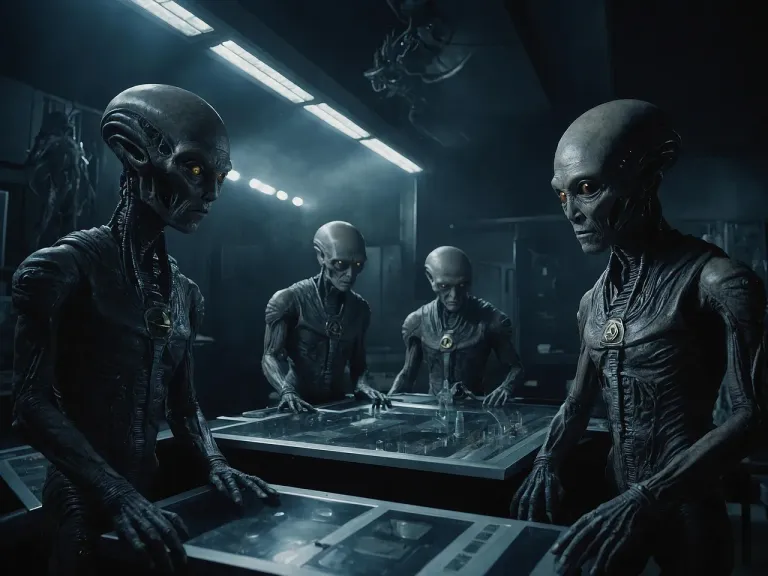Secret Space Program Project Serpo

Project Serpo is a complex and intriguing story that has fascinated ufologists and conspiracy theorists for decades. It revolves around a supposed exchange program between humans and extraterrestrial beings from the Zeta Reticuli star system. The program allegedly began after the infamous Roswell UFO incident in 1947 and involved sending a select group of American astronauts to an exoplanet in the Zeta Reticuli system known as Serpo. These astronauts reportedly spent years in contact with extraterrestrial beings before returning to Earth with extraordinary tales of their adventures. A surviving alien designated EBE1 is said to have facilitated the program, acting as a bridge between humans and its home planet. The origins of the Project Serpo account remain shrouded in mystery.
The first detailed descriptions of the program surfaced in a series of anonymous posts on a public forum in 2005. These posts claimed to reveal the existence of the exchange program and provided extensive information about the astronauts’ journeys and their experiences on Serpo. The narrative has since been supported by a range of evidence, including classified documents allegedly leaked by insiders, testimonies from individuals claiming to have participated in the program, and connections drawn between the Serpo account and elements of popular culture. Despite the seemingly compelling evidence backing the Serpo narrative, skeptics have raised doubts about its authenticity. Critics argue that the lack of verifiable evidence and the fantastical nature of the claims suggest that the story may be a sophisticated hoax or a piece of modern mythology, echoing themes found in classic science fiction tales.
The allure of Project Serpo continues to captivate our imagination. It encourages us to explore what might exist in the vast expanse of space and compels us to consider the implications of potential contact with intelligent life beyond our planet. The controversy surrounding Project Serpo reflects a broader societal interest in unidentified flying objects (UFOs) and extraterrestrial life, symbolizing our longing for exploration and the unknown. Despite ongoing debates about the authenticity of Project Serpo, the story remains a thought-provoking narrative that challenges the limits of our knowledge and imagination.
Interest in the possibility of extraterrestrial life and human-alien interaction extends beyond the realm of science fiction. Over the years, several alleged projects similar to Project Serpo have emerged, each adding to the complex tapestry of stories about interstellar exchanges. Often shrouded in secrecy and controversy, these accounts fuel discussions about the existence of extraterrestrial beings and their potential contact with Earth. One notable example is the story of Majestic 12 (MJ-12), a supposed secret committee of scientists, military leaders, and government officials formed in 1947 to recover and investigate alien spacecraft.
The MJ-12 documents first emerged in the 1980s and have since been the subject of intense scrutiny and debate within the UFO community. While many consider these documents to be a hoax, others believe they provide evidence of a deep-rooted government conspiracy to conceal the truth about extraterrestrial encounters.
Another intriguing account relates to Richard C. Doty, a former United States Air Force sergeant, who claimed to have provided records of an exchange program to journalist Linda Moulton Howe for her HBO documentary “The ET Factor.” According to his narrative, this exchange program was initiated in 1965 and involved 12 individuals selected to visit an alien planet.
The story continues by detailing the return of these individuals to Earth, with some choosing to remain on the alien planet. The concept of human-alien exchanges gained further traction with the release of Steven Spielberg’s “Close Encounters of the Third Kind,” a film that some believe was inspired by actual events. The movie portrays human encounters with extraterrestrials and concludes with a human voluntarily joining the extraterrestrials on their journey back to their planet.
This has led some to speculate about the potential influence of actual classified projects on popular culture. Discussions surrounding these alleged projects often intersect with reports of UFO encounters, which are categorized as Close Encounters of the First, Second, and Third Kind. This classification system was developed by astronomer and UFO researcher J. Allen Hynek. The categories range from simple sightings of UFOs to physical evidence of their presence and, finally to encounters with extraterrestrial beings. While concrete evidence supporting these projects remains elusive, the stories continue to captivate the public imagination. They serve as a testament to humanity’s enduring curiosity about the unknown and the possibility of life beyond our planet. Whether these projects are real or elaborate fabrications, they challenge us to ponder the vastness of the cosmos and the potential for extraordinary encounters.
As we advance our technological capabilities and continue to explore the universe, the legend of these alleged projects encourages us to keep an open mind. The search for extraterrestrial life is not just a quest for answers but also a journey that tests the limits of our understanding and the boundless nature of our curiosity. The stories of Project Serpo and similar initiatives may one day find their place in the annals of human history, not as mere myths but as the first chapters of our interstellar odyssey.
Posted by Waivio guest: @waivio_cosmicsecrets
